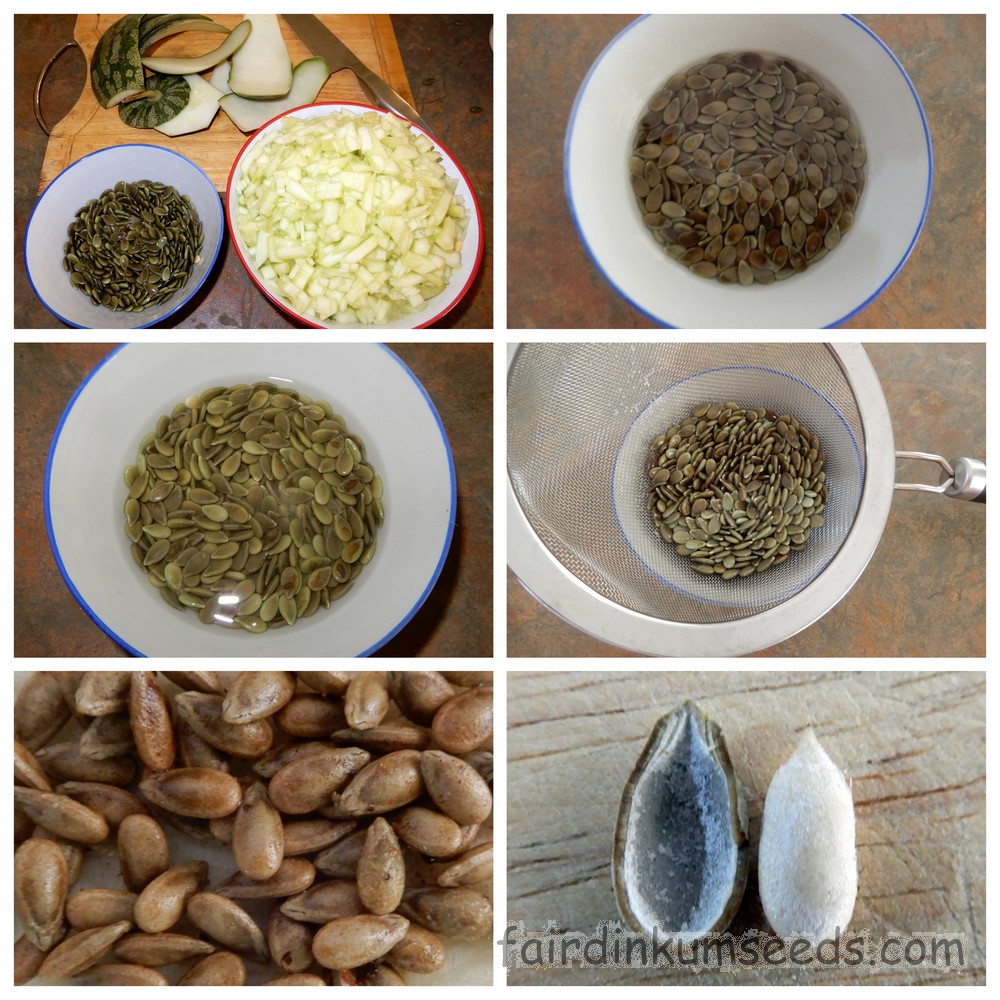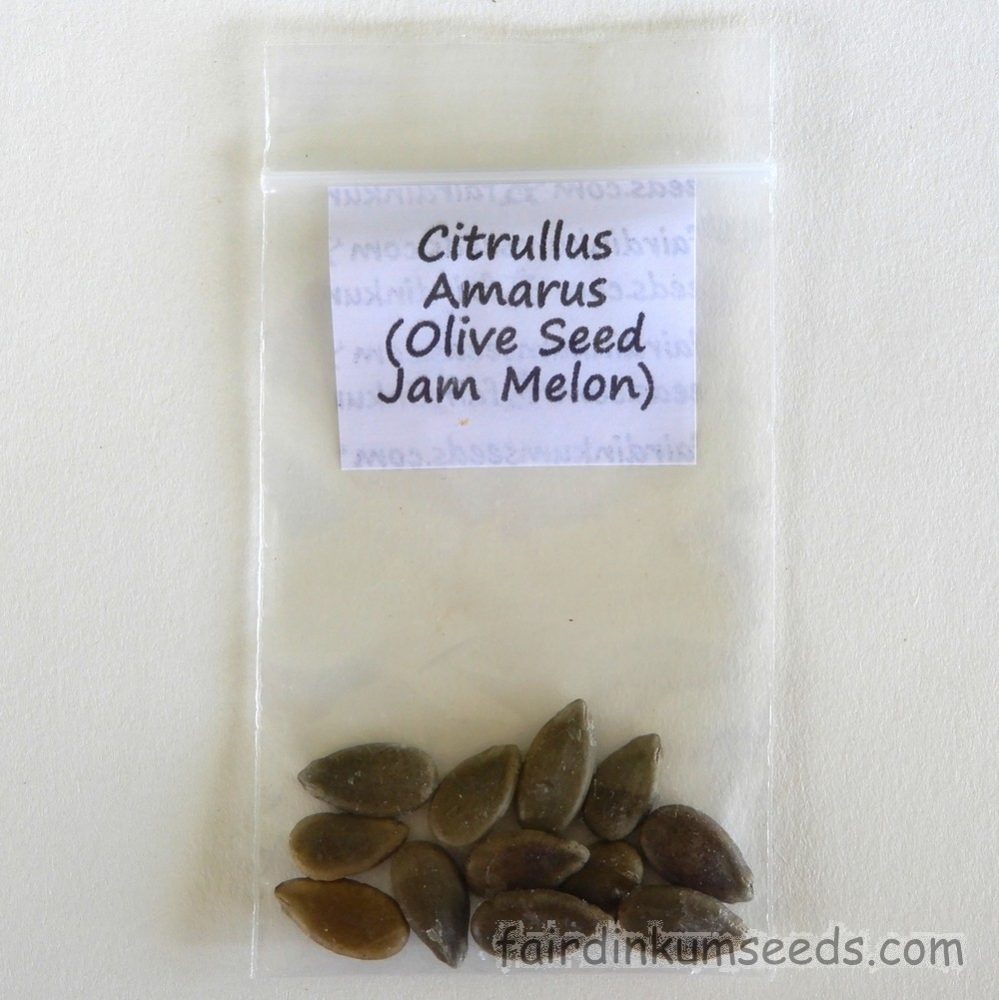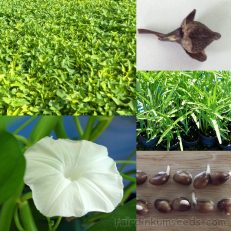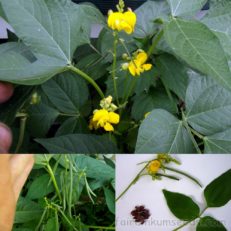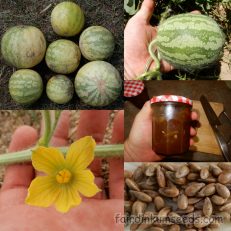Please read text!
Citrullus Amarus Jam Melon Citron Olive Seeds
Packet of 10+ home grown seeds of this very handy species!
While many folks would say this is Citrullus lanantus, I have it on very good authority these are actually Citrullus amarus, a species that is hardly ever even mentioned here in Australia.
I am also told that recent DNA testing proves there are NO wild Citrullus lanatas, and all of the Afghan melons that have been given that name for decades by various government departments, are actually misidentified Citrullus amarus too.
The very pubescent(furry) immature fruit is another sign that they are not Citrullus lanatus which has immature fruit that are nearly always smooth.
Unlike true Citrullus lanatus, these guys start off really hairy like velvet, and as the fruit ages the hairs fall off and it gets the standard glossy waxy skin of a normal water melon.
Oh yeah, I better clarify before folks freak out about the name “Afghan melon”.
Here is Australia there are two species that share that common name, and they are both regularly called Paddy Melons too.
One of them is Cucumis myriocarpus.
It is the true Paddy melon and it is toxic.
It is very easy to identify as it has spiky fruit that look like floating sea mine, and distinctive seeds a lot like Rockmelons or Cucumbers.
They are oval, like a flat football and white or cream coloured.
They taste offensively inedibly bitter, and this is due to the huge amounts of toxic saponoids.
THIS IS NOT THAT PLANT!
The other plant was/is called Lanatus citrullus.
It is the true Afghan melon that was brought over by camel traders back in the day.
Some of the wild forms are bitter and mildly toxic and you find in the bush they should not be eaten, especially if bitter or soapy.
While they were brought over as a food and fodder the best tasting would have died out in the wild early on.
The more bitter and toxic they are, the more likely they are are to have survived generations of natural selection in bush, getting more and more toxic as a defense against grazing animals, which means it’s best not to eat them and stick to domesticated lines.
The bitter soapy bit is the Saponoids and they are not something you want in large amounts.
It was always considered to be just an undomesticated, no/low sugar form of the common supermarket watermelon.
When I just had another look a minute ago every government website and expert authority in the country still calls them that, but recent DNA testing shows that they are in fact Citrullus amarus.
I am certain that the various state and federal authorities will eventually update their information, but unfortunately they have not yet, and as such this correct botanic name is not on the permitted species list for WA and TAS either as no one really knew they existed here until recently.
Sorry folks, them’s the rules, completely out of my hands.
Anyway, I am selling a fully domesticated heirloom form of the Afghan melon, and it has a botanical name of Citrullus amarus.
This one has olive seeds and is not at all bitter or soapy and while I don’t have a lab to analysis it or anything, I strongly believe it is lacking the nasties the wilder forms often contain.
It is grown specifically for cooking, making jams, pickles, preserves, and for the edible high protein seeds.
I originally received the seeds in trade with a customer of ours and I have been growing heaps ever since.
They produce massive amounts of fruit from very little inputs and they are super hardy even the hottest driest summer days.
They are not sweet fruit like a supermarket watermelon, they really have no flavour to speak of at all?
Crispy bland juicy mush.
BUT, they are very nutritious and their crisp spongey flesh really soaks up whatever flavour you add them to.
You can use them as a vegetable in slow cooked stews and pressure cooker meals, and as a filler and thickening agent in jams and preserves.
Great way to stretch a handful of berries or a couple fruit, and the best way to think of it is like choko in an apple pie.
Without the apple and sugar it wouldn’t be great, but you don’t even notice its there as the other guys dominate the flavour and the extra texture makes it better still.
As most folks wouldn’t be aware of how to use them I added a couple basic recipes to get you started at the bottom.
As I was saying, they have been incorrectly identified here for decades, and over the years they have/are also been known as Citrullus caffer, Citrullus colocynthoides, Citrullus colocynthoides var. citroides, Citrullus lanatus var. caffer, Citrullus lanatus var. caffrorum, Citrullus lanatus var. citroide, Citrullus lanatus var. citroides, Citrullus vulgaris var. caffrorum, Citrullus vulgaris var. citroides, fodder melon, citron melon, jam melon, Kalahari melon, pie melon, preserving melon, stock melon, tsamma melon and this one in particular, the Olive Seeded Jam Melon.
It is originally from the Kalahari desert in Africa, and it has spread along the trade routes for centuries as an important food and fodder crop.
It was even grown in ancient Egypt more than four thousand years ago!
Recipes!
Melon and Ginger Jam
Ingredients
1 small to medium ~1.5kg whole jam melon.
500grams sugar.
100grams of native ginger(or about half that of the supermarket stuff).
1 whole lemon or lime.
Instructions
1. Peel the melon using a knife.
2. Cut into thin slices, squeeze roughly to pop out the seeds, then chop finely.(Save the seeds for the next recipe).
3. Finely slice or grate the ginger.
4. Mix the chopped melon flesh, grated ginger, and sugar together, then leave overnight to soften.
5. The next day chop the lemon into quarters and drop them in the pot, then simmer it all on a low-medium heat for ~1hr.
Remove the lemon pieces, then scoop the now finished jam into clean clean jars.
Lid them immediately while hot and they should last a couple years just wacked in a kitchen cupboard.
Great on toast or served with crackers with cheese.
If you don’t have access to Native Ginger you can substitute the supermarket stuff or even powder, but only add about half as much so the flavour isn’t too overwhelming.
If you want something a bit different try using Hot Chillies instead.
Awesome with roast meats and vegetables.
Salty Melon Seed Snacks
Ingredients
The seeds from 1 small to medium jam melon.
100ml of white vinegar.
2 heaped tablespoons salt.
Oil or fat for frying.
Instructions.
1. Add the seeds to the vinegar and salt, then leave in the fridge for 48hrs.
2. They will get lighter in colour and swell during that time. Drain the seeds and dry them well.
3. Shallow fry the seeds in a large pot of very hot oil or fat.
Use a lid and cook for a few minutes or until they all float and are a nice golden colour.
Some may pop like popcorn so be very careful!
Eat them whole shell and all like I do, or peel them first like sunflower seeds.
If you turn then sideward and bite gently, the seed shells split and the kernel falls out.
You can then just spit out the two neat halves of the shell.
Great with a beer or to snack on while doing boring paperwork.
They taste just like roasted almonds.
I often bring a bag full in my pocket to eat out in the scrub, kinda like trail mix.


